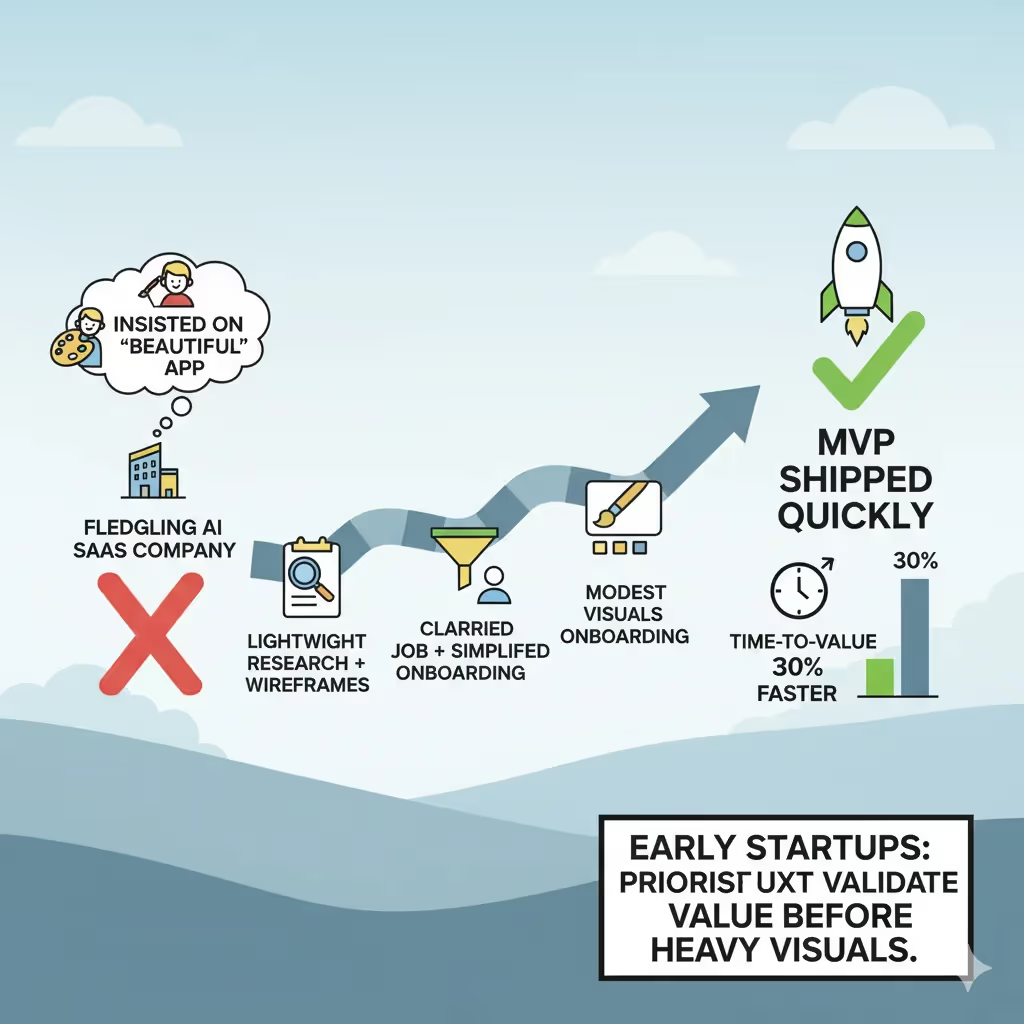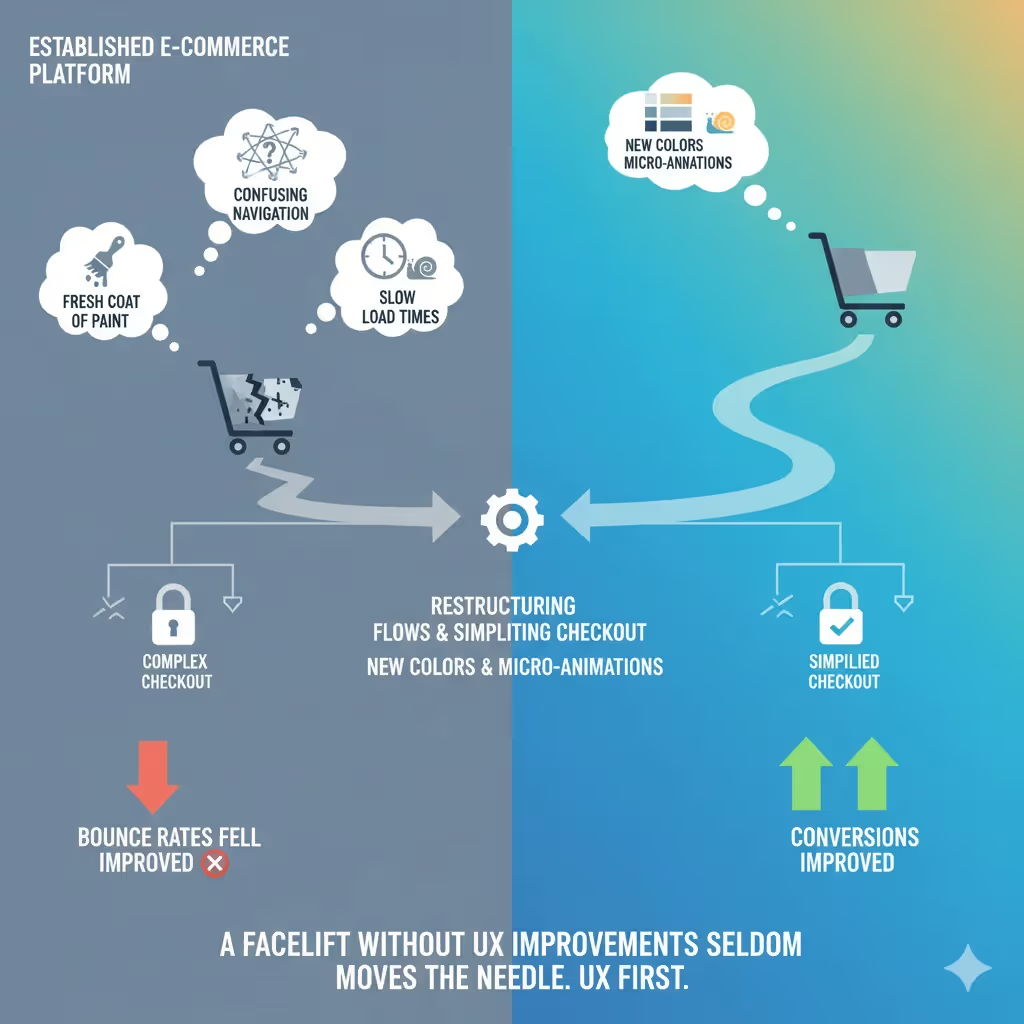UI vs. UX: What Is the Difference? Guide (2025)
Explore the differences between UI and UX design, including definitions, responsibilities, and how they work together.

Apple Music once launched with a slick interface: bold album art, fluid animations, and crisp typography. Yet within days critics and users complained about “getting lost” and not being able to perform basic tasks. Its beautiful skin masked messy navigation and inconsistent flows.
Conversely, Craigslist’s plain text lists and dated visuals inspire trust, letting users find and negotiate deals quickly. These stories illustrate why people keep asking what is the difference between UI and UX. Visual polish alone does not guarantee a great product, and an unsophisticated interface can still deliver value if the underlying experience works. Understanding the distinction helps founders and product leaders avoid wasted investment and design missteps.
What is UI & UX?
Before we explore what is the difference between UI and UX in depth, it helps to define each discipline. User experience (UX) design encompasses the entire journey a person takes when interacting with a product — from discovering a need to onboarding, using features, dealing with errors, and leaving. It goes beyond screens to include service touchpoints, branding, support and even packaging. According to the Interaction Design Foundation, UX design focuses on “designing the entire process of acquiring and integrating a product, including aspects of branding, design, usability and function”. Effective UX work relies on user research, information architecture, flow mapping, prototyping and testing.
User interface (UI) design sits within this broader discipline. It deals with the visual and interactive layer: layouts, typography, colors, icons, buttons, sliders, transitions and micro‑animations that users manipulate. UI designers craft the aesthetic and emotional tone of the product so that it aligns with brand values and feels intuitive. As IxDF notes, UI design aims to make interfaces that are appealing and easy to use, whether through graphical, voice or gesture‑based controls. In other words, UI is about the “look and feel,” while UX is about the “why” and the “how.”

Recognizing that UI is a component of UX is critical. UX designers investigate problems, define user needs, outline features, structure flows and test prototypes; UI designers then translate those insights into concrete screens and visual systems. The CareerFoundry team explains that UX design defines what features are needed on each screen and how they relate, while UI design determines the layout, color schemes and interactive states. Each discipline calls for distinct skills — research, analysis and interaction design for UX; graphic design, typography and animation for UI.
UI vs UX: Elements & criteria
To answer the question of what is the difference between UI and UX at a granular level, consider the common pillars used to judge digital products. The table below contrasts how each discipline approaches those pillars. Short phrases highlight the focus; details are discussed afterward.
1) Visual and aesthetic appeal
UI designers curate colour palettes, typography and iconography to create coherent interfaces. They worry about contrast ratios, alignment grids and the mood evoked by imagery. Done well, aesthetics signal professionalism and build trust; 46.1% of respondents in a 2025 study judged credibility based on design and 94% of first impressions are design‑related, decisions formed within about 50 milliseconds. UX designers consider how those visual choices support readability, comprehension and emotional connection. The goal is clarity and confidence, not decoration.
2) Interactivity
Good UI defines states (default, hover, pressed, disabled) and uses micro‑animations to guide the eye. UI designers craft touch targets, transitions and haptics. UX designers ensure those interactions support tasks: buttons should use the user’s words, provide immediate feedback and reduce errors. Apple Music demonstrates that shimmering cards cannot compensate for confusing flows. UX design makes interactions meaningful and communicative; UI design makes them delightful.
3) Usability
UI designers maintain consistency across screens and devices, adhere to responsive breakpoints and ensure icons are recognisable. Accessibility considerations (contrast, keyboard focus, alt text) also reside partly in UI. UX designers broaden usability to include task flow, error prevention and cognitive load. They map steps, remove friction and test prototypes to detect confusion. Slow loading shrinks conversion by 0.3% per second and 88% of visitors will not return after a poor experience, so usability must span the entire workflow.
4) Navigation flow
In UI work, navigation refers to the visible menus, tabs and buttons. In UX work it refers to the underlying architecture. UX designers create sitemaps, set priorities and define how information is grouped; UI designers translate that structure into clear menus and signposts. Without thoughtful UX, navigation becomes cluttered and users get lost; without careful UI, a good flow feels unsatisfying or confusing.
5) Business and technical constraints
Both disciplines must align with business objectives and technical realities. UI designers ensure visual designs follow brand guidelines and platform conventions while optimizing performance and accessibility. UX designers work with stakeholders to prioritise features, balancing user needs against business goals. Dovetail reports that poor responsiveness drives over half of redesign efforts and that ineffective UX can drain a third of sales, showing why business alignment matters.
The design process: UI vs UX
The design process shows where UX and UI intersect. At Parallel we group work into four phases: research & analysis, structure & design, prototyping & testing, and implementation & iteration. Research surfaces user needs and business goals, an inherently UX activity. Structure & design turn insights into flows and visual systems, blending UX and UI. Prototyping & testing validate solutions and refine details; Dovetail’s data shows that strong UX can increase conversion rates by up to 400% while poor performance drives users away. Implementation & iteration bring the design to life, using analytics to improve and reducing churn (a 5% reduction in churn can increase profits by 25%). This cycle illustrates how good UX research informs UI choices and how polished UI brings strategies to life.
UI vs UX: Use cases & examples
Real‑world examples make what is the difference between UI and UX more tangible.
Startup MVP: A fledgling AI SaaS company insisted on hiring a visual designer to make the app “beautiful.” We instead used lightweight research and wireframes to clarify the core job and simplified onboarding, then applied modest visuals. The MVP shipped quickly and achieved time‑to‑value 30% faster than the original plan, proving that early startups should prioritise UX to validate value before investing heavily in visuals.

Product redesign: An established e‑commerce platform thought a fresh coat of paint would increase sales. We found deeper issues—confusing navigation, slow load times and a complex checkout. After restructuring flows and simplifying checkout, we applied new colors and micro‑animations. Bounce rates fell and conversions improved, demonstrating that a facelift without UX improvements seldom moves the needle.

Good UI, bad UX: Apple Music looked stunning but frustrated users because its navigation was hidden and controls were inconsistent. Polished visuals could not compensate for confusing flows and random auto‑play. Even global brands can misalign UI and UX when they prioritise aesthetics over clear journeys.

Plain UI, good UX: Craigslist’s plain lists and blue links look dated. However, its simplicity fosters trust and keeps users focused on connecting with peers. The site is easy to browse, post and negotiate on, proving that strong UX can thrive despite an unappealing UI.

UI vs UX: Roles & skills
Understanding what is the difference between UI and UX also helps founders hire the right talent.
UX designers conduct research, develop personas, structure content, prototype and test. They deliver wireframes, flow diagrams and insights that frame problems and validate solutions. UI designers craft high‑fidelity screens, define visual language, design states and micro‑interactions and ensure accessibility. In small teams a hybrid “product designer” may cover both, but as products grow specialised roles deepen research, polish interactions and maintain design systems.
How founders and PMs can use this distinction
Being clear about what is the difference between UI and UX helps you make smarter decisions. Write job descriptions that specify research versus visual design tasks and avoid vague titles. Allocate budgets wisely: invest early in UX research and testing because good UX can lift conversions by up to 400% and ROI on UX spending can reach 9,900%, while poor experiences drain roughly a third of sales. Scale up UI investment once the core flows work.
Educate stakeholders that aesthetics alone are insufficient. Use prototypes to show how UX improvements solve business problems and treat UI as the finishing layer. Adopt collaborative tools like Figma or Sketch to align UX and UI work, and track both experience metrics (task success, time and errors) and perception metrics (aesthetic satisfaction, brand alignment). For instance 74% of respondents would revisit a mobile‑friendly site, while 88% would not return after a poor experience.
Common myths & misconceptions: UI vs UX
Many misconceptions obscure what is the difference between UI and ux:
Myth: UI is superficial or less important. Some dismiss UI as “just making things pretty.” In reality, visual design influences credibility and trust; 46.1% of users judge a site’s credibility based on design. A sloppy UI undermines even the best UX.
Myth: UX equals UI. Because they are often used together, people assume they are synonymous. UX covers the entire experience, from discovery to support. UI concerns the interface layer. They are distinct yet interdependent.
Myth: Once the interface looks polished, the experience is great. A beautiful UI cannot mask poor workflows. Apple Music’s example shows that without coherent navigation, users abandon tasks despite impressive visuals.
Myth: UX is only about usability; feelings don’t matter. UX also includes emotional resonance, trust and delight. Craigslist’s plain design fosters trust by feeling uncommercial and open. Good experiences inspire confidence and loyalty.
Conclusion
Design is holistic. Knowing what is the difference between UI and UX shapes how products are conceived and built. UX explores problems and structures journeys; UI brings those journeys to life with visuals, typography and micro‑interactions. Neither discipline is more important; both must work together. For startups, validate flows through UX and then invest in UI. As you scale, invest in research, design systems and accessibility. The reward is a product that not only looks good but feels right. Remember: what is the difference between UI and UX is about perspective and scope.
FAQ
1) What are UI and UX examples?
UI refers to the look of an onboarding screen — its colours, type sizes and animations. UX refers to the entire checkout flow: adding items, entering shipping details, paying and getting a receipt. The UI is one touchpoint; the UX is the whole journey.
2) Why do people say UX instead of UI?
Because UX covers the entire journey — discovery, usage, support and beyond, whereas UI focuses on the surface.
3) Which is better, a UI or UX designer?
It depends: hire UX designers to uncover problems and model workflows; hire UI designers to craft visuals and polish interactions.
4) Is Figma a UX or UI tool?
It supports both; you can wireframe and prototype flows (UX) and design high‑fidelity screens and components (UI).
5) How do you decide the split between UX and UI?
Prioritise UX research and flow design early. Once workflows are validated, invest in UI for brand, trust and efficiency. Maintain a balance as the product matures.

.avif)











